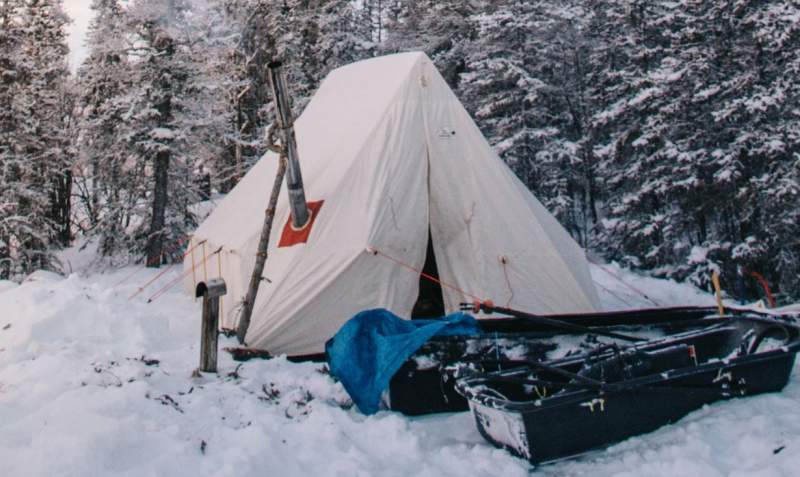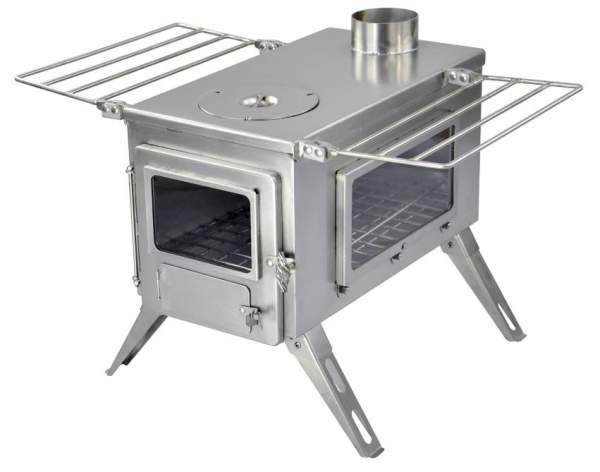If you plan to camp in a cold environment, you might want to know how to heat a tent, so keep reading, you will find the answer here.

Should you heat your tent?
If you are in an environment similar to what the picture above shows, then the answer is obvious. Great sleeping bags may not be enough to feel pleasant and comfortable.
Is there a safe way of heating tents?
The short answer is yes, there is a whole industry with stuff related to this. This includes specific tents, various heaters/stoves, and accessories.
Modern tents are built from fire-retardant materials. Though some manufacturers do not use them to avoid chemicals that are normally applied to the fabric. You can read more about this in my separate text. But fire and tent’s fabric do not go well together and some precautions are necessary.
What exactly you will need for heating a camping tent?
Most of the texts on the Internet are focused on how to keep a tent warm in cold weather. The point is you cannot; if it is cold outside, then it will be cold inside as well. So if you want a warm tent, you will have to heat it. There are two basic elements here:
- An appropriate tent. You can have i) small backpack portable tents, and ii) larger camping tents suitable for places with a motorized access.
- A heat source that fits the tent.
Regarding the heat source, there are generally two main options:
- Use a wood-burning tent stove. There are great tent stoves on the market and you can use them both for heating and for cooking. The beautiful example shown below tells you what you can have. Imagine how pleasant it is in a tent with such a stove with glass windows on two sides.
- Use a tent heater that works with fuel canisters. This can be particularly convenient for the mentioned backpack-portable tents, but you can use such heaters in larger tents as well.


In the case you plan to use a heater, it may help if you also use an insulated tent. Yes, you are reading correctly, there are indeed some really great options on the market. With such tents you will not need lots of extra heat to make the atmosphere in the tent pleasant. The picture below shows one great example, a shell tent with a cocoon insulated tent that fits inside.

Which features are needed for a heated tent?
Here are a few important elements and design features needed for the tent where you will use heating:
- It is essential to have a tent designed to preserve warmth or tents for cold weather camping. Without this, heating would be pointless. This means that all or most of the openings (windows, doors, vents) should be closable. There are many tents on the market, in particular in the EU, which come with solid windows. In this case, you rely on vents that are normally always available.
- In the case of heating by a wood-burning stove, the tent should have a pipe jack corresponding to the stove’s pipe design. We have a separate list of tents with integrated pipe jacks so please have a look.
- Choose a stove with the heating capacity corresponding to the tent’s size and temperature conditions outside. You can see more in our separate text on how to choose a tent stove.
- There are tents on the market that come with a wood-burning stove included, with a stove jack, and with a removable tent floor in the area where you would position the stove, see the picture below. But if the tent floor is fully sewn-in, make sure that you have some protection underneath the stove.

- The tent should be large enough to accommodate the stove. This means that the stove should be at some distance from the walls, you will find this indicated in specifications of the stove.
- Carbon monoxide is slightly lighter than the air and if it develops, it will spread. So make sure that the tent has vents.
- Regarding the tent’s fabric, most of those that are currently on the market are canvas tents. So they are heavy, bulky, expensive, but also very durable and reliable. Canvas will give a bit of insulation which you do not have in any synthetic tent.
Which features are needed for the heat source?
- I already mentioned the pipe jack, so if this is about a wood-burning stove, it should have the pipe that corresponds to the tent, or vice-versa if you like. So if the tent has a pipe jack on the side wall, then the pipe should be directed appropriately. There are elbow elements on the market, pipe extensions of various types, roof-protecting pipe segments, etc., have a look here.
- The stove or the heater should be of the heating capacity appropriate for the tent. This is much better defined in the case of propane heaters, you will have their BTU value indicated. With the wood-burning stove, this is far more difficult to determine. So make sure that the firebox is not small and that the pipe diameter is large. Check our list with such wood-burning stoves, we gave some indications for most of them.
Wood burning tent stove vs propane heater – what to choose
Note that these two cannot really be compared. What I give below is an overview of some features that may be more or less important to you, so that you can choose easier.
Cooking
Ease of use
Weight
Heating capacity
Versatility
Free fuel
Wood burning stove
Propane heater
Cooking: Wood-burning stoves will allow you to cook and heat the tent. Propane heaters are what their name tells you.
Ease of use: No doubt propane heaters are much easier to use, usually more compact, and do not require many special arrangements regarding the tent.
Weight: Wood-burning stoves tend to be heavy, but see this Winnerwell Fastfold Titanium stove which is a collapsible and ultra-light exception.
Heating capacity: For larger tents, you should think of a wood-burning stove.
Versatility: Propane heaters are far more user-friendly and you can use them anywhere (if you are working in the garage, in your garden shed, etc) and set up in seconds.
Free fuel: Well, if you camp below the tree line, then go for a wood-burning tent stove.
Price: Wood burning stoves can be very expensive, but again, there are exceptions.
In any case, if you plan to do some winter camping in a heated tent, it is best to test your equipment in controlled conditions close to home and safety.
If you go for summer camping, you might also want to know how to keep a tent cool in summer. See also my texts on how to cook in a tent and how to choose a tent for camping in the rain.
Thank you for reading. Please let me know if you have some question or comment, there is a comment box below.

A tarp is actually makes a better all season shelter than anything I have seen. All sides kept tight to the ground when it is cold and windy all sides propped open to be an umbrella shade. A set of 2”x 14” tapered chimney makes a good centre or side pole. Google chimpac
Eventually the cook outside gas stoves will be scraped. The use of them is stopping a lot of people camping. It is just no fun.
There would be many more people out and about if the were out of the wind cooking inside with a little chimney supporting their tent and venting a tiny wood burning cook stove.
Google chimpac
The heating as you describe certainly can work. It is also easy to agree that cooking inside is more pleasant when it is cold. But I do not see a tarp as the best all season shelter, there are insects when you camp in a warmer climate, and with a tarp you have no protection at all.